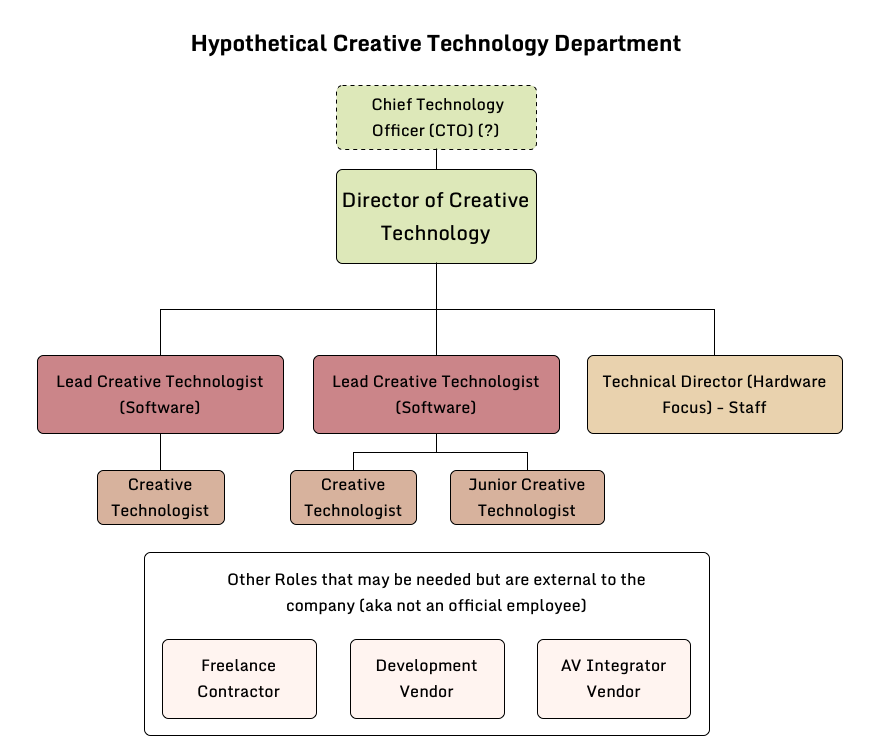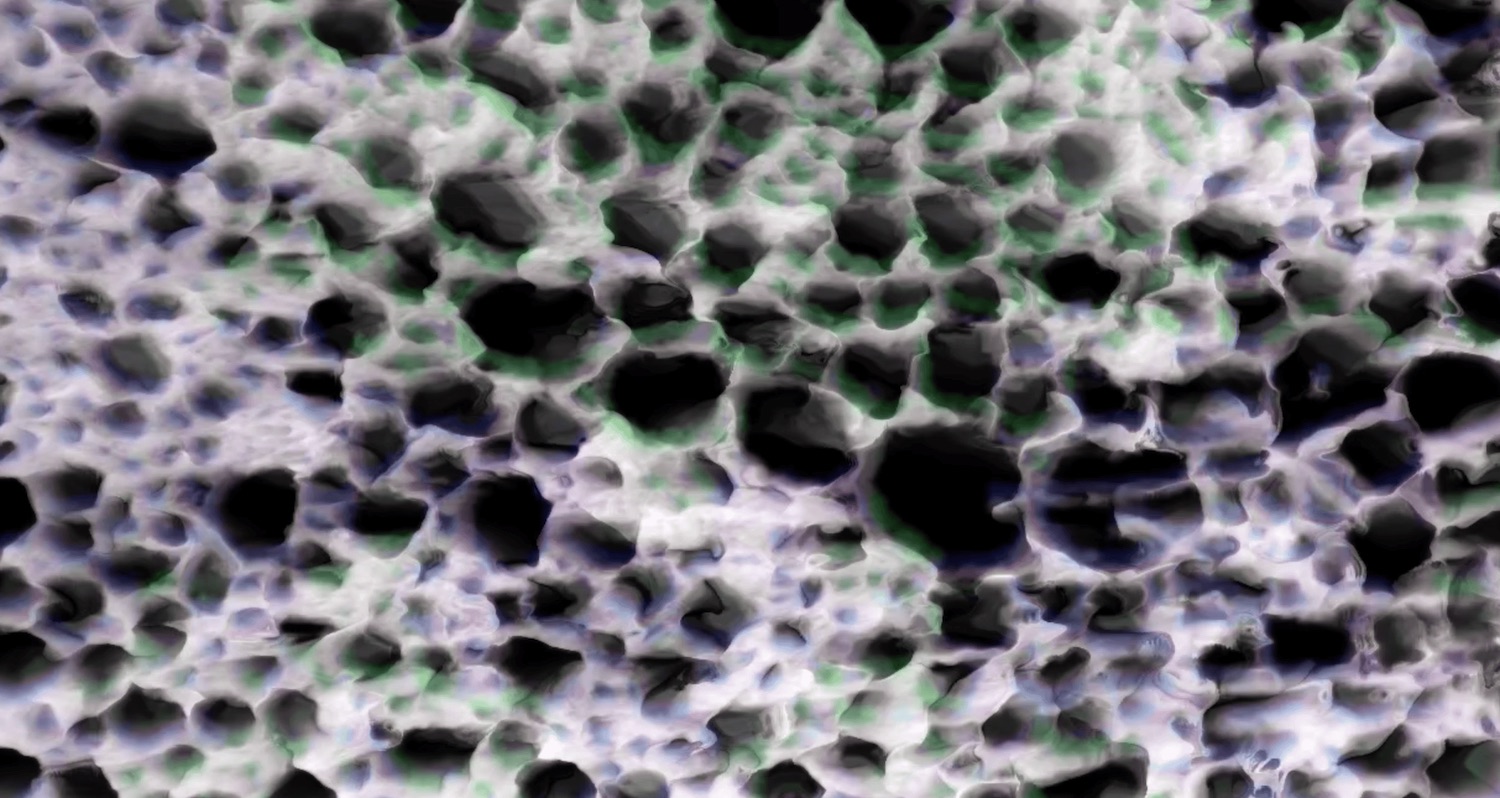Link to Previous Part: Intro and Part 1
Part 2: Department Overview
In part 1, we looked at what a creative technology company looks like at a sort of macro level and where a department falls within a larger company structure. Now we'll zoom in a bit to the individual department level and the various roles that fall within that specific team. In part 3, we'll look at the entire company within a project that might have multiple levels of involvement.
Creative Technology Department
Let's look at a Creative Technology department. In general, this is the team that provides creative solutions and technology oversight on projects, develops software, integrates with hardware, and performs research on new tools. It has some leadership-oriented people, and some that may prefer just working directly on project oriented problems and tasks. To start from the top, some organizations may have a Chief Technology Officer (CTO) depending on the size, typically you have a creative tech department lead that reports to them (or is one in the same). This person does things like helping to set goals for the department, setting up and championing good processes, and overseeing all projects from a high level - diving into details only when necessary. Depending on the size of the department, there may be multiple roles like a lead creative technologist or a technical director that will manage an individual project. Other department roles may be simply various levels of the title of “Creative Technologist” with a mix of individual contributors and people managers. Skill sets may vary from hardware expertise, to incredibly varied software expertise in everything from TouchDesigner, game engines, javascript, backend systems, and more.
Due to cost, many companies have to be very strategic about the skill sets needed (generalists versus niche platforms) and seniority levels they bring in. A company may lean towards more of a “We can do it all” or ”Diner menu” mentality that can tip them towards needing more creative tech generalists who have a “T shaped” skill set. These T-shaped generalists might have a wide (and shallow) range of knowledge about all things creative tech and one or two “deep” specialized skills. Other companies may choose to specialize in a particular aspect of Creative Technology and may say: “We only do augmented reality for the mobile web” which means that they can focus their hiring efforts considerably, but they also have the tradeoff of having a potentially narrower client base that only wants mobile web AR. Both approaches are certainly valid and have tradeoffs between casting a wide net for client projects and level of executional skill.
With all that in mind, below is a diagram of a hypothetical creative technology department structure for a small company with a generalist focus.

To describe the diagram a bit more - The Director level typically handles things like department goals and direction, hiring, planning, staffing projects, career advancement, setting individual goals, and helping to guide processes. Lead Creative Technologists or Technical Directors are a bit more on projects and may split their time between team and project management and some active development. The Creative technologists and other members may work more directly on projects but will still have a bit of creative and architectural input to how things are done. Next we'll take a look at how this same setup might be split up across active projects.
Creative Technology Department Structure on Projects
Moving past a department structure, there is the consideration of how that same structure plays out when actively working across different projects in production. Here is where it is critical to balance individual skill sets, budget, time, interest, seniority level, and other elements across the right projects. You may have several projects running at once - maybe several small projects with only a small creative tech component, and maybe one large project that has multiple layers of software and hardware that is taking up most of the team’s resources. Balancing teams and timing across the constantly shifting sands of project-based work will take a large chunk of time for Creative Tech department leads.
The scale of the project may necessitate the need for a separation of a hardware lead and a software lead. While there is a ton of crossover on hardware/software, there can be a ton of time involved in dealing with the specifics of the hardware and integration with the built environment. The creative tech lead will work with the department lead to identify things like project scope, milestones, and overall project health. Also depending on the scale of the project, the software lead may be developing significant parts of the project, or just overseeing the process and jumping in on specific elements. Next up, the creative tech lead oversees the general or specialized developers with the right set of skills for the project - and these might be a mix of full-time employees, freelance individual contractors, or a small vendor with several developers working together.
Below is a diagram that gives a hypothetical view of how a creative technology department might split resources across several different project types - like a consumer facing AR app, a sound-based experiential project, and a permanent installation involving web technologies.

Questions for department leads to consider at this level:
- How does this scale?
- What does this kind of structure look like at 5 employees and 2 projects versus 50 employees and 10 projects? What about 200+?
- How many people do you need per project?
- How do you balance the capital “C” creative members with the capital “T” technologist members of the team? Some might need more technical mentorship, and some may want to be more involved on pitch and concept work.
- Can a technical project lead do heavy software development or get too “in the weeds” and still be an effective lead?
- My answer: I think it is difficult for a lead of a team to get too involved in the weeds of development and deployment. The tradeoffs often are that their technical skills can often lose a bit of sharpness if they aren’t actively developing something, or that the larger picture for the team can get lost if they are too deep in details on a particular project.
- Is there a better way to structure these project teams? The approach above feels like a "standard US agency" based approach, but there are many others.
- How does it change for a short term versus long term project?
- Who are your next 3 most needed hires and what are their skill sets?
- How many specialized skill sets can you reasonably have "in-house" versus needing to hire specialized freelancers?
- What is your company’s “specialization”? Is it easier to focus on your core competencies and then either find trusted partners or hire freelancers each time?
- How do you make space for Research and Development projects (that don’t necessarily generate revenue in a clear way) while also keeping up with paid client work?
- What is the challenge or value of productizing some of your offerings?
- How do you split off time to template out or productize certain repeatable elements of your creative technology work?
- How many times would something need to be used repeatedly to be worth the investment in productizing?
- Do the rest of the teams feel aligned to "re-sell" the product being built or considered or is it mostly a tech team initiative (for example - a small communication or monitoring utility vs a larger complete app/SaaS tool)?
- How do you onboard new hires into this structure and explain the working process?
- Similarly, how do you onboard new freelancers and vendors to your process and how do you vet these new team members?
- How do you balance the need for consistent process and the need for flexibility across vastly different projects? Too much rigidity to process can make it difficult to work with other teams.
- What is your team's own "API"? -> How do you balance your team's internal process (for example: how do code reviews work, when do we push things live) vs external process (for example, how do you interface and update the creative team and production team when challenges arise?)
- Are people burning out or does their workload feel manageable?
- Are people getting burnt out from working on the same kinds of projects all the time, or too many different ones?
- How many projects can one person work on simultaneously?
- My personal answer for a developer: 2 in production - maximum, and maybe 1 in pre-production/concept creation. Context switching is expensive.
- Are people being mentored appropriately?
- Is there a clear path for career growth from one level to the next? How do you make this explicit to the team?
- If flat hierarchies are preferred, who ultimately makes tough decisions?
- How do you build multiple coherent paths for people who want to be more of a manager, or more of a creative, or more of an engineer - and are those paths necessarily divergent?
In Part 3, we'll cover how these departmental and company structures fit into an overall project structure that may involve other vendors, clients and other entities. Thanks for reading!

[…] In Part 2, I’ll be exploring the micro level of just a hypothetical Creative Technology department within a company […]